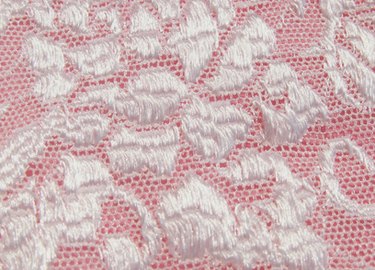
A beautifully handcrafted lace tablecloth takes hours of work and concentration, resulting in an expensive addition to your home decor. In the late 19th century, the Quaker Lace Company made it possible for middle class households to afford the opulence of lace by producing beautiful machine-crafted lace. The company continued to offer all manner of lace items throughout the 20th century, and in the process became a household name.
Quaker Lace Company Background
Video of the Day
The Quaker Lace Company began in 1889 as the Bromley Manufacturing Company. Bromley Manufacturing was founded by the three sons of John Bromley, an English carpet maker who came to the United Sates in the 1840s and became successful in textiles. The Bromley brothers wanted to manufacture a machine-made lace, so they used the profits from the carpet business to purchase lace looms, which were imported from Nottingham, England. In 1894, the Bromley brothers purchased a factory on 4th and Lehigh Avenue, and renamed the company Lehigh Manufacturing. Shortly after, they opened another factory on 22nd and Lehigh, and in 1911 they renamed the business one last time and it became Quaker Lace Company.
Video of the Day
Introduction of the Tablecloth
Quaker Lace Company's biggest item was the lace curtain, but it was apparent to the company that times were changing and tastes were shifting, so they began exploring other products. Quaker Lace made mosquito netting for the military during the war, and then came upon their best known post-war product: their tablecloth, first produced in 1932. The Quaker Lace Company's lace tablecloth even adorned the White House table during the Eisenhower administration. In fact, the heaviest of their lace tablecloth patterns is called the White House.
Affordable Luxury
Quaker Lace Company became the leader in machine-made lace, and it rivaled Nottingham's lace, which was known as some of the finest in the world. The machine-made lace was an affordable luxury supplied to the middle class. The lace was durable, resisted stretching and pulling, and could withstand washing without losing its shape or transparency. It adorned tables and even found its way into women's fashion. Quaker Lace Company provided advice to female buyers on trimming clothing in their lace, suggesting it to accent bridal wear, hats, coats and linens.
Decline and Bankruptcy
In 1987 the 4th Street factory was closed, but tablecloths were produced at the plants that had been opened in Lionville, Pennsylvania, and Winthrop, Maine. The company continued by researching and inventing new ways of chemically treating the lace so that it would maintain its shape. The tablecloths were mainly sold in department stores, and when many of these stores began to close, Quaker Lace Company's profits declined. The company finally declared bankruptcy in 1992. The pattern and name was purchased by Lorraine Linens, which continued to manufacture the lace tablecloths until 2007 when Lorraine Linens went bankrupt.
Vintage Revival
Quaker Lace tablecloths still remain a sought-after item because they are so durable and beautiful. The original White House pattern is one of the more desirable patterns because it is a rare find. Though no longer manufactured, some companies distribute replicas of the Quaker Lace tablecloths.